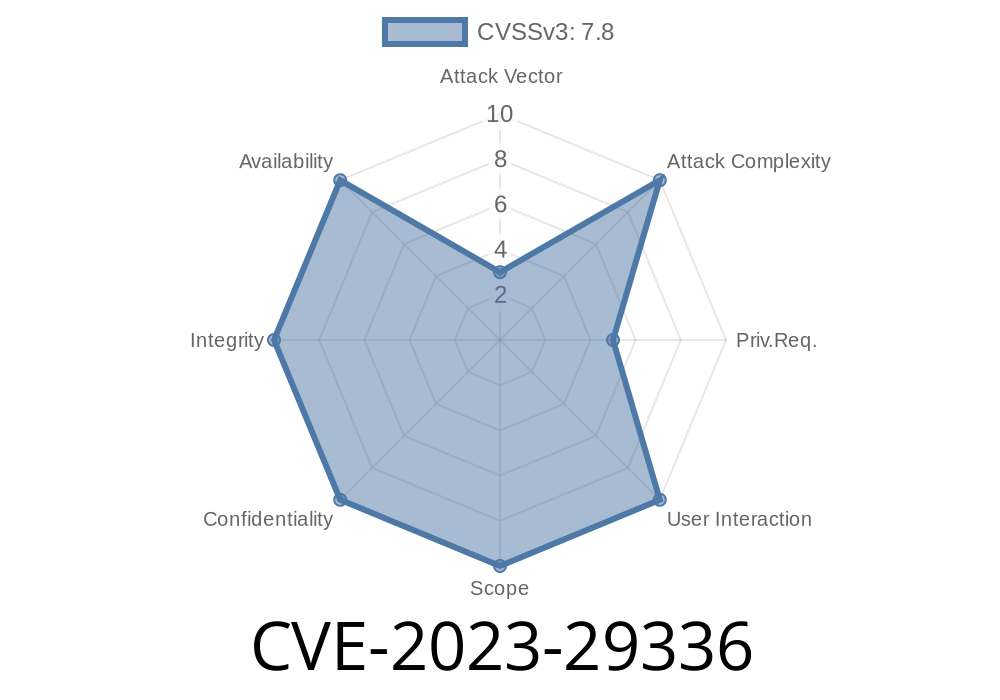If you're running a Windows machine, system security is critical, and vulnerabilities in the Windows kernel can be devastating. In this post, we'll take a deep dive into CVE-2023-29336, a Win32k Elevation of Privilege Vulnerability disclosed and patched by Microsoft in May 2023. We'll cover what it is, how it works, its dangers, and even show some example exploit details for educational purposes.
What is CVE-2023-29336?
CVE-2023-29336 is a vulnerability in the Win32k driver (a core Windows component responsible for GUI operations) that allows attackers to elevate their privileges. In plain terms, a local attacker could get full SYSTEM access—effectively taking control over the computer.
Microsoft issued a patch on Patch Tuesday, May 9, 2023. The bug was rated Important and was actively exploited in the wild.
Original advisory:
Microsoft Security Response Center: CVE-2023-29336
GitHub write-up (vercel.com)
Details: What's Vulnerable?
The bug resides in the NtUserSetWindowLongPtr function in win32k.sys. Attackers able to execute code on the system could manipulate certain window properties, causing the kernel to access freed memory (use-after-free, UAF), ultimately allowing for privilege escalation.
Platform:
Affects most modern Windows versions (Windows 10, Windows 11, Windows Server 2022, etc.)
Attack Vector:
The attacker creates a window and abuses the way Win32k tracks extra window memory.
2. Through a race condition, the attacker manages to force a use-after-free on internal window objects.
3. By reclaiming the freed memory with attacker-controlled data, it's possible to trigger code execution as SYSTEM.
1. Creating the Vulnerable Window
A "WindowLongPtr" is extra memory attached to windows in Windows' kernel structures. When a window is destroyed, this memory is freed.
2. Triggering Use-After-Free
By carefully managing window lifetimes and manipulating certain functions (SetWindowLongPtr, DestroyWindow, etc.), the kernel accesses invalid (freed) memory.
3. Gaining SYSTEM Privileges
By spraying the heap and controlling the freed memory area, an attacker could plant malicious pointers, leading the OS to execute code chosen by the attacker.
Example Proof-of-Concept (PoC) Snippet
Here is a simplified (non-harmful) code snippet inspired by public write-ups. For full proof-of-concept code, see the vercel blog.
// Step 1: Register a window class and create a window
WNDCLASS wc = {};
wc.lpfnWndProc = DefWindowProc;
wc.lpszClassName = "CVE202329336Class";
RegisterClass(&wc);
// Step 2: Create window and manipulate its extra memory
HWND hwnd = CreateWindow("CVE202329336Class", "Test", WS_OVERLAPPEDWINDOW, , , 100, 100, NULL, NULL, NULL, NULL);
// Step 3: Set window property in a way that could trigger the race
SetWindowLongPtr(hwnd, GWLP_USERDATA, (LONG_PTR)x41414141);
// Step 4: Destroy window from a different thread to force race condition
CreateThread(NULL, , (LPTHREAD_START_ROUTINE)DestroyWindow, hwnd, , NULL);
Sleep(100); // Give time for race
// Steps after this would include heap spraying to reclaim freed memory...
Note:
Above code does not demonstrate the real exploit, but shows the style of window and memory manipulation used.
For full technical details, read the excellent analysis on vercel blog.
Impact
With this vulnerability, a regular user on your computer or a malware running with user rights can break out and gain SYSTEM privileges. This means total control: install/modify software, read private files, disable antivirus, and more.
According to Kaspersky, this bug has been used by threat actors such as APT groups to escalate privileges as a part of more complex attacks. See Kaspersky’s summary for a deep dive.
Patches & Mitigation
To stay safe:
Use endpoint protection; it may catch generic heap spraying or privilege escalation attempts
Official Microsoft Bulletin:
- MSRC Patch Details
Further Reading & References
- MSRC Advisory: CVE-2023-29336
- vercel.com Blog: CVE-2023-29336 Win32k EoP PoC
- Kaspersky Analysis: Zero-day flaw CVE-2023-29336
- Windows Internals: Learn more about SetWindowLongPtr
Conclusion
CVE-2023-29336 is a reminder that even subtle bugs in core OS functions can have dramatic security consequences. If you haven't updated your Windows systems since May 2023, do so urgently! For security researchers, this is a fascinating example of how race conditions and memory management issues can lead to kernel-level exploits.
Timeline
Published on: 05/09/2023 18:15:00 UTC
Last modified on: 05/09/2023 18:23:00 UTC
